






Click here for more of our photos of Bologna
Warning! You are about to read a lot about a dish that many would think could be discussed in one paragraph – Bolognese Ragu. After two trips to Bologna, I really began to understand how seriously the people there take their food. Because we are always on the search for the traditional and authentic ways of cooking regional specialties, I was fascinated by the depth of information, history and passion the Bolognese have for this sauce. It is a testament to the amazing people and culture of this small city. Here at We Are Never Full, I’m sure you’ve already grasped that we really want to know the history and culture behind the food we make. The best part about this sauce, you will learn if you dare continue reading, is that it differs from family to family and is still a cause of debate within the city as to ‘what is an authentic recipe’. We think it’s well worth a read – but if you don’t agree, skip to the bottom for the recipes. – amy and jonny
Alessandra Spisni’s Ragu w/ Red Wine (w/ Homemade Garganelli)
We spent two separate short trips to Bologna in the Emilia Romagna region of Northern Italy – the first in late 2006 and the second last summer (2007). Within the first few minutes of arriving in the city, I instantly fell in love. Now, don’t get me wrong, I love Rome, but I fell in deep, passionate love with Bologna. Besides being one of the most influential culinary cities in Italy (and the world), it is also beautiful, rich in culture and very livable – plus, they know how awesome they are without having ego. To make us fall in love even harder, my husband’s favorite author, Umberto Eco, is a professor of semiotics at University of Bologna. And even though we recently received a $322 ticket from the City of Bologna for supposedly driving in a ‘locals only’ zone last July (oh, we’re fighting this one HARD), I still have much love for the place.
There are probably two things that come to mind when one thinks about Bologna, whether or not you have visited it – Pasta Bolognese (or Ragu alla Bolognese) and bologna (sing it with me if you know it, my bologna has a first name it’s O-S-C-A-R), sometimes written “baloney” in American-speak (which gives me a shiver up and down my spine). We could write a whole post (which, come to think about it would be a good idea… I’ll add it to the list) on REAL, AUTHENTIC bologna, called mortadella, not the crap that’s sold with the O-S-C-A-R/ M-E-Y-E-R label on it. But we’ll save that lesson for another day. This post is going to be an ode to the hearty, fabulous and traditional sauce – the Ragu alla Bolognese.
Ragu w/ Chicken Livers and Milk (with Homemade Tagliatelle)
Many people may mistake a Ragu alla Bolognese sauce for a ‘meat sauce’ which is right to a certain extent. But most Bolognese people would die if they heard it described as just a meat sauce because it is so much more to them. The problem is, like many other authentic Italian dishes, Pasta con Ragu alla Bolognese has been reinvented into an over simplified meal (read: finding faster, cheaper and grosser ways to cook it) by other countries (ie: “Spag Bol” in England or “Ragu – It’s IN There!” jarred American red sauces) and has also become a sort of tourist-trap meal. I remember even while in Spain seeing Spaghetti Bolognese on a tourist menu – in SPAIN. You know what I’m talking about – those gross tourist restaurants that have the large sign in the front begging you to come eat there with pictures of each menu item they serve. People, if you don’t know how to translate Spaghetti Bolognese into English and you need a picture to show you what it is, PLEASE, do yourself a favor, keep walking! Not to mention that the picture usually resembles a bit of overcooked noodles with a can of red dog food plopped on top. Narsty.
What is important for you, dear-readers-on-the-search-for-the-authentic-and-traditional, to know and understand is if you are ever in Bologna/Northern Italy and they try to serve you Spaghetti alla Bolognese do not, I repeat, do not order it and immediately leave that restaurant. The Bolognese would never pair their traditional ragu with spaghetti since it is not a local type of pasta – it is local to the south, specifically Napoli. Tagliatelle would be a very traditional pairing, even tortellini, two types of egg pasta created in Bologna. Although I jest, you can choose to eat Bolognese with Spaghetti in Bologna if you so choose, I’m just trying to help you ‘spot the tourist trap’. It’s very important when traveling (wink, wink).
Today we’re going to talk about making the real, the traditional and the authentic Ragu 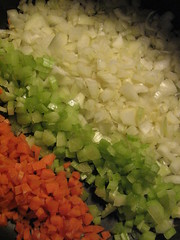 alla Bolognese sauce. It’s a regional specialty that has many different ways to make it depending on family recipes and methods. All the recipes include soffritto (carrots, onion and celery), meat and wine. Some include a few other ingredients including some sort of cured meat like pancetta and others add sausage. Other recipes are a bit bolder and more complicated, adding milk or cream (a source of controversy with the Bolognese), some add nutmeg and white wine, while others use a mixture of meats. But, the one thing all Ragu recipes have in common is that they are all to be made with love and patience because it should always simmer away for hours for the flavors to build. This ain’t no 30-minute meal.
alla Bolognese sauce. It’s a regional specialty that has many different ways to make it depending on family recipes and methods. All the recipes include soffritto (carrots, onion and celery), meat and wine. Some include a few other ingredients including some sort of cured meat like pancetta and others add sausage. Other recipes are a bit bolder and more complicated, adding milk or cream (a source of controversy with the Bolognese), some add nutmeg and white wine, while others use a mixture of meats. But, the one thing all Ragu recipes have in common is that they are all to be made with love and patience because it should always simmer away for hours for the flavors to build. This ain’t no 30-minute meal.
Back when the sauce was created, old cuts of beef were used which were very tough – long simmering was necessary and was known to create flavor. Oh, and you know what else is often missing from a traditional Bolognese sauce? TOMATO. Yup, that’s right folks, I know you don’t want to believe it but it’s true. At best, most authentic Ragu alla Bolognese recipes will only have a bit of tomato paste or some whole, peeled tomatoes. But, then again, that may depend on which Bolognese ‘mama’ you talk to. As Anna Nonni, owner of a restaurant outside of Bologna, says in the latest issue of Saveur, “[Ask] ten women, you’ll get ten different recipes, all of them traditional.” I like the idea that each recipe has been passed down through the years by family members. In fact, this is still a hotly debated issue in the area – will the real Ragu please stand up, please stand up?
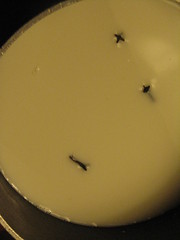 On a lazy Saturday, Jonny and I were inspired by the latest issue of the wonderful Saveur (#110) magazine to create two different types of Ragu alla Bolognese. That issue of Saveur contained six different recipes for ragu. We had the time to spare and we were curious to do side-by-side comparisons of two very different, but traditional recipes. I chose the most simple recipe (Alessandra Spisni’s Ragu alla Bolognese) and a more complicated and richer recipe containing chicken livers and milk (Ragu Enriched with Chicken Livers). If we had time and stovetop space to cook all six, we would’ve! Bottom line, both sauces were absolutely, ridiculously delicious and I would recommend anyone who wants to impress family and friends to choose to make either. There was something so unbelievably satisfying about the Spisni’s Ragu. It was so simple to make, I felt like I barely cooked. I just let the gas stove do the work. To me, it was the quintessential Italian meal – simple and hearty with flavors coming together with time to blend perfectly. It tasted like the Bolognese I ate in Bologna. Spisni’s Ragu is almost exactly the same as the Ragu recipe that is in the “La Cucina Bolognese della Tradizione” (Traditional Bolognese Cooking) cookbook I bought at the famous Tamburini food store (Via Caprarie 1, Bologna, TEL: 051234726), so I feel like I tested three Ragu recipes!
On a lazy Saturday, Jonny and I were inspired by the latest issue of the wonderful Saveur (#110) magazine to create two different types of Ragu alla Bolognese. That issue of Saveur contained six different recipes for ragu. We had the time to spare and we were curious to do side-by-side comparisons of two very different, but traditional recipes. I chose the most simple recipe (Alessandra Spisni’s Ragu alla Bolognese) and a more complicated and richer recipe containing chicken livers and milk (Ragu Enriched with Chicken Livers). If we had time and stovetop space to cook all six, we would’ve! Bottom line, both sauces were absolutely, ridiculously delicious and I would recommend anyone who wants to impress family and friends to choose to make either. There was something so unbelievably satisfying about the Spisni’s Ragu. It was so simple to make, I felt like I barely cooked. I just let the gas stove do the work. To me, it was the quintessential Italian meal – simple and hearty with flavors coming together with time to blend perfectly. It tasted like the Bolognese I ate in Bologna. Spisni’s Ragu is almost exactly the same as the Ragu recipe that is in the “La Cucina Bolognese della Tradizione” (Traditional Bolognese Cooking) cookbook I bought at the famous Tamburini food store (Via Caprarie 1, Bologna, TEL: 051234726), so I feel like I tested three Ragu recipes!
On the other hand, the Ragu Enriched with Chicken Livers recipe blew my socks off,  probably because it had those other elements of flavor that just made it stand apart from the Spisni’s Ragu. For instance, this recipe used milk, cloves, nutmeg and white wine. There were also more steps involved than Spisni’s (ie: making a tomato-paste broth and simmering milk with cloves) and the use of three types of meat, pork, beef and chicken livers, was slightly flavor-changing. I’ve always been a big fan of cloves and nutmeg in cooking and these spices, combined with the use of milk, created a beautiful ragu.
probably because it had those other elements of flavor that just made it stand apart from the Spisni’s Ragu. For instance, this recipe used milk, cloves, nutmeg and white wine. There were also more steps involved than Spisni’s (ie: making a tomato-paste broth and simmering milk with cloves) and the use of three types of meat, pork, beef and chicken livers, was slightly flavor-changing. I’ve always been a big fan of cloves and nutmeg in cooking and these spices, combined with the use of milk, created a beautiful ragu.
Because of the hotly debated topic of ‘what is authentic ragu’ in Bologna, in 1982, the Bologna chapter of the Accademia Italiana della Cucina researched and investigated what should be the official recipe of Ragu. This academic society whose aim is to preserve Italian food and techniques created the “Classic Ragu alla Bolognese”. We didn’t choose to test this one because it was more similar to the Ragu with Chicken Livers recipe and we wanted to distinct and different flavors to compare. But check out the recipe here.
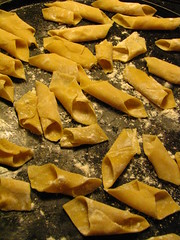 I am copying these recipes virtually word for word from Saveur magazine because I followed this recipe word for word (except I added just a touch more tomato paste in both). I really hope you will trade in your store-bought meat sauce for one of these recipes. At least, I hope you give a big F-You to people like Sandra Lee and Rachel Ray by screwing the ‘semi-homemade’ or ’30-minute meal’ rule and taking the time to try these long-simmering sauces just once. I promise, you won’t be disappointed. Better yet, make a huge batch, then ‘Rachel Ray’ your little heart out by grabbing some leftovers from the freezer for a delicious and authentic 30-minute meal! If you can’t go to Bologna, bring Bologna to you!
I am copying these recipes virtually word for word from Saveur magazine because I followed this recipe word for word (except I added just a touch more tomato paste in both). I really hope you will trade in your store-bought meat sauce for one of these recipes. At least, I hope you give a big F-You to people like Sandra Lee and Rachel Ray by screwing the ‘semi-homemade’ or ’30-minute meal’ rule and taking the time to try these long-simmering sauces just once. I promise, you won’t be disappointed. Better yet, make a huge batch, then ‘Rachel Ray’ your little heart out by grabbing some leftovers from the freezer for a delicious and authentic 30-minute meal! If you can’t go to Bologna, bring Bologna to you!
ALESSANDRA SPISNI’S RAGU ALLA BOLOGNESE (makes alot – about 8 cups)
Ingredients:
- 1/2 cup lard (butter works)
- 3 small yellow onions, finely chopped
- 2 medium carrots, finely chopped
- 2 ribs of celery, finely chopped
- 2 lbs. ground beef chuck
- 1/2 cup dry red wine
- 2 3/4 cups canned tomato puree
- water
- Salt and fresh ground pepper
What to do:
- Heat lard in heavy-bottomed pot over medium heat. Add onions, carrots and
 celery and cook, stirring frequently, until vegetables are somewhat softened, about 8 minutes.
celery and cook, stirring frequently, until vegetables are somewhat softened, about 8 minutes. - Raise heat to medium-high, add beef, and cook, stirring constantly, until meat is broken up and just cooked through, 6-8 minutes. Add the wine and cook, stirring occasionally until evaporated, about 4 minutes.
- Stir in tomato puree and 1 1/2 cups water and bring to a boil over high heat.
- Reduce the heat to low and simmer, partially covered, stirring occasionally until the sauce is thick – about 2 to 2 1/2 hours. Season with salt and pepper and serve over pasta.
RAGU DI FEGATO DI POLLO (Ragu with Chicken Livers) – makes 4 cups – double recipe to match one above
Ingredients:
- 4 cups beef broth
- 2 tbsp. tomato paste (I added a bit more, maybe one more tablespoon)
- 1 cup milk
- 3 whole cloves
- 1/3 cup extra virgin olive oil
- 2 tbsp. unsalted butter
- 1 2-oz. piece of pancetta, finely chopped (I went to my deli and asked for a 2 inch round that I cut up)
- 2 medium carrots, finely chopped
- 2 ribs celery, finely chopped
- 1 medium size yellow onion, finely chopped
- 3/4 lb. ground beef chuck
- 1/4 lb. ground pork shoulder (I used regular ground pork)
- 1 cup dry white wine
- 1/8 tsp. freshly ground nutmeg
- 2 chicken livers (about 2 oz.)
What to do:
- In a small saucepan, bring broth to a simmer over medium heat. Put tomato paste into a small bowl and pour in 1 cup broth; stir to dissolve. Set tomato-infused broth aside (Keep remaining broth hot.)
- In another saucepan, bring milk to a simmer over medium heat. Add cloves, remove from heat and let steep, covered, for one hour.
- Meanwhile, heat olive oil and butter in a large heavy-bottomed pot over medium-low heat. Add pancetta and cook until fat has rendered, stirring occasionally. Add carrots, celery and onions and cook, stirring occasionally until soft and caramelized (about 30 minutes). Stir in beef and pork, cook, breaking meat apart with wooden spoon, until browned. Season with salt and pepper. Increase heat to medium-high and add wine and cook until wine is evaporated.
- Lower heat to mediu, stir in nutmeg, and reserved tomato broth and cook, stirring occasionally until liquid is absorbed, about 5 minutes.
- Lower heat to medium, low and add 1/2 cup reserved hot broth and cook until liquid is absorbed, stirring occasionally. Repeat 1/2 cup at a time until all broth has been used (kind of like risotto) – this can take some time. ***NOTE: Although this may seem very time consuming, don’t take it too seriously. You can walk away and do other things during this ‘liquid absorbing’ part. Don’t go stir crazy – this does not have to be perfect!
- Add chicken livers to the sauce and cook for 8 minutes until soft. Using a fork, mash livers on the side of the pot (or remove and do it on a plate) with a tablespoon into the sauce. Add the milk and simmer until thick and velvety – another 15 to 20 minutes. Season with salt and pepper and serve with pasta.
Check out some other posts you may enjoy:
- LIDIA’S LAMB CHOPS (Lamb Chops with A Mustard Anchovy Sauce)
- GNOCCHI DI PATATE WITH A BROWN BUTTER, SAGE, BREADCRUMB SAUCE
- ORECCHIETTE WITH SAUSAGE AND KALE
- ITALIAN-STYLE SLOW ROASTED PORK SHOULDER WITH SALSA VERDE
- LIVORNESE FISH STEW
- PAPPA AL POMODORO (Tuscan Tomato and Bread Soup)
- SWEET ANISE-FLAVORED SALMON IN A POUCH (SALMON EN PAPILLOTE)
- SPATCHCOCK CHICKEN (A TUTORIAL)
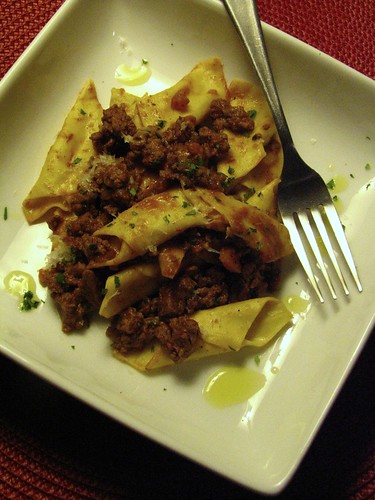

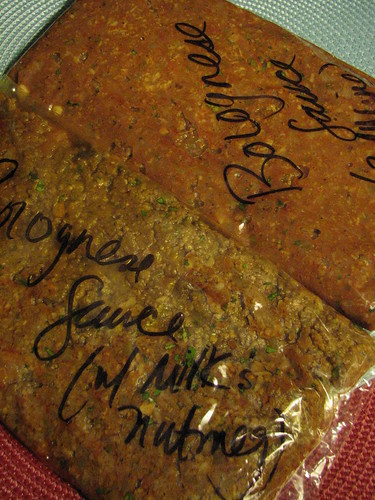
How long did it take you to write this?!?! 🙂
I haven’t had ragu in sooo long. I got turned off from pastas
about 4 years ago after I got food poisoning at an Italian resto in DC. That was not fun. I love Italian but it kind of scares me… I know, I know, just that one incident shouldn’t kill it all.
I’m spending 30 minutes on your site as of now. I have so much catching up to do. Oh, and yes, I was in ur city last weekend, but girl, it was so crazy. We had 7 hours to make it all happen. I’ll email you with details.
I’ve tasted some pretty bad sauces and I’ve seen worse of food shows! I like both your sauces here…low & slow shine here.
I also understand where the Bolognese come from when they get pissed about their sauce.
I cringe when I see anything other than Greek feta used, a traditional Greek dish get abused or margarine use.
GREAT POST!I want to try that chicken liver sauce right now. Excellent recipe.
mmm my favorite, my recipe was given to me by my Neighbor growing up who also was very proud of her version. it is pretty much the same as the first one you listed, but add ground veal with the beef.
i always judge a restaurant by their Bolognese, and down here in the south, i just make my own instead of even thinking about it…8-)
Wow. This is a great post! I agree with you 100% when you say people should try this at home. They would never go back to the ground beef and tomato sauce they’re used to. I made a bolognese last week from a recipe in a cookbook by Giorgio Locatelli (which i highly recommend). It was phenomenal and very close to your recipe. Now i want to try the other one, the ragu with chicken livers sounds amazing. Thanks!
Yumm, thanks for the in-depth run down on making a proper ragu. I’ve never had the patience to make a proper Bolognese, but the chicken liver one looks fit for my short attention span:-)
Such an eye opening post!
i am the type who will ALWAYS fall into tourist traps easily, even in hong kong haha! you might as well cross the word “tourist” and replace it with “rita” hahaha
Never a big fan of spaghetti, so glad to learn that they normally pair the sauce with tagliatelle 🙂
now…let me eat that “authentic” Hong Kong style spaghetti bolognese dish in nearest fast food joint tonight….:p haha haha ha
Very informative post 🙂
wow. i have yet to finish reading this post as I’m tryin to stay focussed on this movement of Aestheticism. :S but will definitely come back to read more. your blog’s cool! thanks for stopping by mine. very heartening comments,
cheers my friend.can’t wait to come back to your blog
x
Oh thank God! I read that same article and had this sinking feeling that I was going to be trying out A LOT of Bolognese, and now you’ve gone and done it for me! Thanks SO much! It relieves me of my obsessive desire to find perfection in Bolognese, and leaves me with more time to pursue whole grains. Hmmm…can you imagine any two items being more opposite one another?
I loved your post; and I loved the Saveur story; honestly, you could have helped write the magazine article.
Of course, you know me…..any opportunity to give big heavin’ F-you to RR.
Thanks for stopping by my blog, your comments were much appreciated.
I LOVE this post (and I envy the heck out of your travels – I turned as green as Kermit reading it). I have loved traditional ragu for years, but it’s been hard to find a good one. I am constantly looking for recipes hoping to develop my own in the future. (I would rather surrender my kitchen than use a sauce from a jar.)
I’m with 10 kate as well. We don’t need no stinkin’ 30 Minute versions. You can’t tell me adding chicken stock will give it slow-cooked taste!
Authentic recipes that come right from the region are the best! Wow, these look and sound delicious! Thank you for sharing. I want to go to Italy!!!
Who knew bolognese was so intense? Great post.
and this is what happened:
so i’m reading along and i get to the pic of the chicken liver ragu dish, and i stopped and went “oh my” and really just looked at that photo. and i’m not even hungry… then i bookmarked it. i am so very gonna make this version. i’ve been meaning to and just never have.
I’m so sad that I’ve never had an authentic ragu, because I am not a pork eater. It always looks so lovely and smells fantastic whenever we’re in Italy. I ask my husband to order it, and tell me all about it. Your post makes my mouth water….
Yes, this post took a long time. It’s funny b/c we often take to writing these posts like I’m writing a paper for college. I should start writing a bibliography and footnotes. Thanks for all these comments… they keep us going. I also really appreciate everyone who really learned about the ragu for the first time by actually reading this post!
and all y’all (zenchef, coco, claudia, etc.) who were drawn into the chicken livers ragu – ohhh yeah baby… you’ve gotta make it. In fact, I’d even throw in an extra liver just to be naughty.
I’d love to have one of those bags in the picture in my posession!:)
Great post!!
what a wonderful post! I lived in Bologna for almost 2 years and enjoyed every minute. I completely understand the pride they have in their cooking. I often tell friends that in most cities, you need to search for good restaurants…. in Bologna you trip over them. Love your blog! Joe
I’m making the Bolognese tomorrow night! Alfredo just last night suggested that we have that on Friday since we have to carbo-load our son for his swim meet on Saturday…..amazing that you had the recipe waiting for me!
xoxox Amy
A sauce off! Great idea.
I’m another one who’s intrigued by the ragu with chicken livers. I
imagine the different meats plus the small amount of liver would give it a really interesting complex taste. Are either of these now your official house ragu or are you still checking out other recipes?
Hey, Julie! Thanks for stopping by. I would say that the beef/red wine ragu will be more the staple cause it’s very simple and extremely tasty. BUT, with that said, if I have livers on hand and a bit more time to do the extra work the second ragu needs, I would most definitely make that over the first. They are both great, but, like you said, the liver + different meats + milk/cloves,etc. really does give a robust flavor.
but sauce #1 is a great and easy staple. I’ll def. sample another authentic recipe in another few months, I’m sure! -amy
Sorry, it’s taking me ages to get here….with laptop being completely destroyed – i no longer have one and we need to get another one (like super duper quick!) hence, my not being able to blog hop as frequently.
ANYHOW, I’ve yet to read through your bolognese with chicken livers sounds wonderful and perhaps it would be the perfect way for me to sneak into M’s food w/o him knowing. 😉
I can’t lie. I’ve never met a ragù I didn’t like…these both look fabulous 🙂
It was a long one but definitely worth it. Lots of good info and the sauces really sound outstanding. I’m glad you put this together and I really like the idea of including chicken liver–that must be riiiiich! *drool*
Thank you for directing me to this recipe. I’ve made ragus like the first, but never like the second, so I’m looking forward to trying that recipe myself.
Perhaps because we didn’t know exactly what we were doing, and because ECG and I were terrified of parking/driving fines, I didn’t enjoy our visit to Bologna. Oh well, I’ll have to save to for another trip to Italy to learn about that city and how it really works.
I tried the first recipe last night. I was fearful at first that there weren’t enough herbs in the recipe, but it came out terrific. I tried some of the left-over sauce today, and it tastes even better the next day (actually, quite a bit better the next day). I admit to adding a dash of Worster sauce — not sure if it made much difference. Thanks for posting the recipe. If you ever find yourself in mid-town Manhattan and want to try the BEST bolognese sauce ever, check out Teodora. I swear, I can’t get it off my mind since I ate there a few weeks ago. The other dishes are amazing and authentic too and relatively reasonably priced.
Hi, Nancy. I’m so curious which ragu you made? with or w/o livers. and growing up in an italian-american household, we definitely understand that pasta ALWAYS tastes better the next day! I think all the flavors really have a chance to mellow all together. thanks for the recommendation of Teodora. Jonny works in midtown and, unfortunately, we usually want to stay away from the area when we’re not at work, but this may help us go there on a weekend! I just checked out the menu and it does look delish and got great reviews. Thank you so much for trying the recipe and offering your opinion! stop by again, please!
I spent a year living in BO and this post brings back so many wonderful memories! Tamburini was a staple lunch spot — just cannot top their tortellini! Next time you find yourself there you must try Trattoria Anna Maria for the best lasagna you’ve ever tasted….oh and do not get me started on the gelato 🙂
Thanks for posting this Bolognese blog. I made the Ragu Di Fagato di Pollo and couldn’t be happier with how it turned out. I made it for some friends who were still raving about it two days later.
I used substituted veal instead of ground chuck. I also used those gelatin veal demi glaze substituted for beef stock. I used one packet and mixed it with four cups of water. It was a very rich and complex dish. I made a double batch the other day to bing up to an up coming ski trip (it’s in the freezer).
It’s all about fagato di pollo!
I have been experimenting with the Saveur recipes since that issue came out last year. We live in Nothern Italy and so have the advantage of getting very nice ingredients (and, living 2 hours from Bologna, we can go tasting).
Although I like all of the recipes in the magazine, I keep making a variation of Anna Nonni’s recipe. It works fine to use only olive oil (instead of half-and-half with butter). Shallots work just fine if you don’t have onions. I use a very lean pancetta affumicata and put in a little bit more than the recipe calls for. Additionally I usually use ground veal instead of beef and I put in less beef/veal and more ground pork. I use double concentrate tomato paste and polpa di pomodoro (crushed tomatoes) in bottle rather than pureeing a can of tomatoes. Finally, I use good red wine. Last batch had a Vino Nobile di Montepulciano that added some good flavor.
It is fun to get into discussions about this with my Italian friends. My friends from the Veneto think it is sacrilege to add pancetta and have offered to have their nonna come over and help us make it the RIGHT way. But they are just describing the sauce they know.
Cool article.
Instead of water you should use homemade beef stock in your ragu. It is one of those things they don’t tell you. It makes a big difference. Also, use a bit of muscata for flavor.
This is the kind of article that should be written on Italian food, brilliant! You can’t write about Italian cooking without mentioning how defensive they are about their recipe, its history and what it means to them, very well done. It took me back to my homeland, born in Rome but raised in Spain an the caribbean, Chef by profession (no more restaurant work tho) and avid keeper of traditions specially if it is Italian cooking. Read it all without stopping, can’t say enough, very well done.
I still prefer the one with chicken livers, that’s how I make it.
I’m working on my website (just under construction page now) that I planned to launch by the end June or beginning of July, but don’t hesitate to contact me if you desire. People that take food the way you do should be kept close, BRAVISSIMO!
Wow, Marcos. Thank you so, so much for your comment. It really keeps us going! Please stop by again.
Good article; I realized some time ago that I am a “purist”. I lived and studied in Bologna for 7 years; the tagliatelle ala bolognese is something sacred. The real Bolognese food is casalinga, that made in Italian homes. You learn one thing in Bologna, the pasta “is” tagliatelle, tortellini, tortelloni, and the infamous lasagna “verde”. The signora where I lived arose at 5:30 am on a Sunday morning and the lasagna verde was served at 2 pm in the afternoon. That is the epitomy of la cucina Bolognese.
Wow… you sure had me fooled… i really thought you were a professional, until I got to the “F-you” part; so much for integrity!
hey, angela –
thanks for your comment – sorry if a little “f-you†offended you! it is a personal blog and sometimes, well, i get a little personal. sandra lee gets me a bit nuts and i took my creative license to show so. i’m just glad i didn’t write the whole “f†word out!
either way, thanks for stopping by. i’m glad you were able to get through most of the post before the offending line at the end.
amy @ we are never full
WOW! Brava! I love Bologna also and I try to go visit there a few times a year. Just spent 5 days there, an eating frenzy of joy. I love eating in Italy-loved reading your post!
I write a blog on health/food/wellness-going to link this article in with my series on food from Bologna.
Continued success 🙂 ! Buon Appetito.